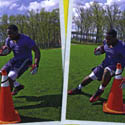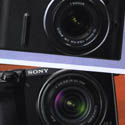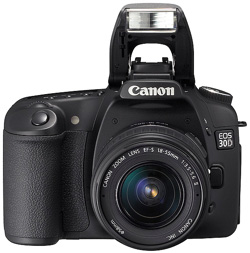Compact System Cameras
By Brian Raftery | June 5, 2012 | 6:30 am

That vacation to Yellowstone is too exciting and too beautiful to document with just a smartphone. This emerging category of delivers DSLR-grade images sans DSLR-grade bulk. -JACKSON L
THE BASICS
Are these DSLRs or point and shoots?
Neither. They eliminate the bulky mirrors and prisms that power a DSLR's viewfinder, so these cameras are smaller, lighter, and cheaper. But their manual controls, interchangeable lenses, and big sensors (typically either APS-C or micro four-thirds, the same units found in consumer DSLRs) make them far more versatile than point and shoots.
I'm not ready for a step up in complexity.
These models have simple interfaces, so if you're used to a point and shoot, the only stepup you'll take is to much better photos.
Are there any drawbacks?
These are bigger and heavier than point and shoots-no slipping them into your pants pocket. And because there's no DSLR-style viewfinder, you have to compose with a tiny electronic viewfinder or back-panel LCD. The broad range of maximum-zoom apertures here (typically f3.5-f6.3) can make it difficult to get a shallow depth of field.
BUYING ADVISE
All the cameras in our roundup take sharp, accurate shots that can be printed beautifully as large as 16 by 20 inches. The differences are in their interfaces: Some serve pros looking for a backup camera, while others are beginner-friendly. Here's a quick test: Pick up a camera and try to adjust the ISO, video frame rate, and exposure settings in less than two minutes. If you fail, look for something simpler or prepare to spend some time learning.098 WIRED JUN 2012
Panasonic Lumix GX1 RATING: 9
No company is more responsible for establishing this category than Panasonic, which has been steadily dialing up the goodness in its Lumix compact system cameras since introducing its first model four years ago. While the new GX1 is the lightest camera here-just 11.2 ounces-its 16-MP micro-four-thirds sensor has almost twice the real estate of the Nikon's CX chip and boasts improved white and color balance. Only the Sony beat it on image and video quality, and just barely. The robust control options definitely qualify the GX1 as a shooter's camera, but the elegant menu and touchscreen LCD welcome novices. WIRED Zoom and manual-focus levers Ingeniously placed right on the lens barrel. Love the barely-there dimensions-and price! TIRED Zoom on the Included 14-42-mm lens Is twitchy and Imprecise In video mode. Autofocus struggles In low light. $700
Pentax K-01 RATING: 7
The K-01 is the best-looking camera here. Thank industrial designer Marc Newson, who simplified the exterior and controls while preserving Pentax's K lens mount and finding room for advanced guts that exceed the com• pany's top DSLR in some areas. The 16-MP APS-e sensor-the largest (by a hair) in our test-turned in razor-sharp images, saturated colors, and superb low-light performance. But at a DSLR•esque 19.8 ounces, it wouldn't be our first choice as a vacation companion. WIRED Shoots Video at three resolutions and 11 frame rates. Works with Pentax's entire range of lenses. TIRED No dedicated viewfinder. What weight savings? $750
Nikon 1 V1 RATING: 6
With the V1, Nikon debuts new less-is-more thinking. It's got fewer external manual controls in favor of more novice-friendly aids like Smart Photo Selector, which rattles off 20 stills in less than a second and picks the best five before letting you choose the keeper. The speedy autofocus can track subjects at 10 fps-if there's enough light. When there's not, the 10-MP sensor struggles mightily. WIRED Dedicated electronic viewfinder. Hot shoe for flesh. Includes two lenses. Tl RED No pop-up flesh. Small proprietary CX sensor. Horrid manual focus. $1,150 (includes 10- 30-mm, f2.5- f5.6 lens)
Sony Nex-7 RATING: 8
The 24-MP APS-C sensor produced the best stills and videos of the bunch, with details that held up even when we zoomed in. The minimalist magnesium-alloy camera features an OLEO viewfinder, articulated 3-inch LCD screen, and three customizable dials for configuring controls. That's a good thing, because the cluttered onscreen menu is the one glaring flaw. WIRED Most cuatomlzable model here. Sparkling 1080p video at 60 fps. TIRED Menu is a bit of a dog's breakfast. Flimsy pop-up flash. At least $300 too expensive. $1,200









